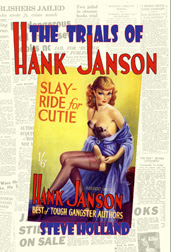Monday, July 21, 2025
Bob Haberfield & His Art
In his introduction to the latest book from Jayde Design, Ben Haberfield relates his father's story: Bob Haberfield was raised by his mother in Melbourne, Australia, after his father was killed during WW2, leaving school at 13 to become an apprentice mechanic. Quitting after a couple of years, he attended Melbourne Tech from the age of 16 doing a night course in graphic design and life drawing while working as a layout and design trainee with an advertising firm.
He was taught and influenced by artists Clifton Pugh and Ian Stone who encouraged him to paint, particularly abstract painting, which he first exhibited in 1964 to positive reviews. He met Melanie, a young Englishwoman who had worked as an au pair in Paris, and she became his second wife in 1967; their honeymoon was Bob's first experience of travel outside Australia.
Renting an apartment in Paris, Bob painted record sleeves and perfected his talents as a flamenco guitarist, but moved to London when Melanie fell pregnant. The strain of having to earn a living yet to not compromise his artistic vision proved too much; while Melanie took their son Ben on holiday to Italy, Bob emptied their flat in Elgin Avenue and disappeared. Introduced to Buddhism, he joined a commune in Wales.
He was by then regularly painting covers for Mayflower, and the Buddhist influence can be seen in many of these painted in the early 1970s. Although Melanie tracked him down and joined him in Wales, commune life became increasingly controlling and she left. Bob also left, destitute (all his earnings from painting went to the commune) and living on the streets around King's Cross until a friend paid his fare back to Australia.
He returned to advertising, working hard and drinking hard. The loss of his girlfriend to breast cancer saw him heartbroken and he returned to London in 1981 to try to reconnect with his son, whose mother was running a clothes shop in Camden Road. Shortly after, he moved to a commune in Manchester, and later to a house in Wales, but his drinking was getting worse. A blazing row with his son meant he cut off contact for a year before phoning to admit that he had been wrong and that he had been sober ever since. The two developed a relationship that was to last.
Retiring from his career in illustration, Bob spent his time painting and listening to music until his death in 2021, aged 83.
This semi-tragic tale lay behind the dozens of covers and illustrations that Bob Haberfield painted for records, books and magazines, as well as his years in advertising between the early 1960s and his death 60 years later. Across the pages of two books, hundreds of pieces are presented for the first time for anyone outside of Bob's family as—beyond a handful in his early days—he never exhibited or sold his work.
In the first book we are introduced to Bob Haberfield The Man, with essays by his son Ben Haberfield and friend Garry Kinnane, and some 300 pages of artwork; in the second we have Bob Haberfield His Art, which is a curated gallery of his career, including books—memorable and instantly recognisable from the covers of Moorcock, Jack Vance, Cordwainer Smith, Brian Aldiss, Robert Silverberg, Roger Zelazny, etc.—records and an incredibly diverse range of illustrations and advertisements. This volume also includes the reminiscences of various friends and followers.
This is the volume for me. Bob Haberfield's covers were a mix of surrealism, Hindi and Buddhist imagery and bright, rainbow colours. If your knowledge of the surreal is Dali or Ernst, these are more subtle pieces in a trippier headspace. It lends itself to horror stories, of which he illustrated plenty, most notably Clark Ashton Smith and HP Lovecraft for Panther in around 1973-74, and one of his most outstanding images, the motorcycle-riding Hitler on Norman Spinrad's The Iron Dream. But from the same brush came covers for children's books by Enid Blyton and Paul Galico, and it is a treat just to wander through the rich imagination on show throughout both books, whether you want something realist or something abstract.
This is a beautifully printed pair of books designed by John Coulthart, that slip into a sturdy case, published by Jayde Design who you'll have met here at Bear Alley as they published James Cawthorn: The Man and His Art and Cawthorn's The Stormbringer Sessions some years ago. The quality of the books is up to that earlier standard.
Bob Haberfield: The Man and His Art compiled by Ben Haberfield, with John Davey and John Guy Collick. Jayde Design ISBN 978-106838612-1, 28 July 2025, 376+232pp, £52.00 [slipcase edition, price includes shipping within the UK]. Order from Jayde Design.
Note: Bob Haberfield has an official website.
Labels:
Bob Haberfield,
Review
Subscribe to:
Post Comments (Atom)





























































No comments:
Post a Comment